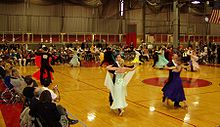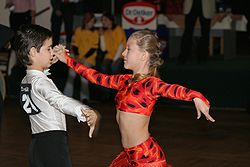- Dancesport
-
Dancesport 
An amateur dancesport competition at MITDancesport denotes competitive ballroom dancing,[1] as contrasted to social or exhibition dancing.
The name was invented to help competitive ballroom dancing gain Olympic recognition.[2]
Dancesport events are sanctioned and regulated by dancesport organizations at the national and international level.
The physical demands of dancesport has been the subject of scientific research.[3][4][5][6]
Contents
History
The first unofficial world championship took place in 1909,[7] and the first formation team[8] was presented in 1932 by Olive Ripman at the Astoria Ballroom, London.[1][9] Dancesport was first broadcast on TV in 1960.[10]
Styles
The term dancesport applies only to the International Style of competitive ballroom (often referred to as Standard or Modern) dancing and Latin dancing.[11] Today, it includes the following style categories:
- Standard
- Latin American
- Ten Dance
These categories apply to both individual couples and formation dance.
International governing organizations
World Dance Council
The World Dance Council (WDC) is a registered limited company, and the legal successor to the International Council of Ballroom Dancing (ICBD), which was formed in 1950 in Edinburgh.[7] The WDC operates through a general council and two committees:
- The World Dance Sport Committee regulates professional dancesport at the international level.
- The World Social Dance Committee "deals with all matters of the dance profession that relate to the activities of Dance Schools and Dance Teachers".[12] It does not regulate social dance directly – that is the business of individual organisers, the dance teacher organisations, such as the Imperial Society of Teachers of Dancing, and the chains of dance teaching schools in the United States (such as the Arthur Murray organisation).
In 2007 the WDC Amateur League was created.[13] This organisation runs a number of competitions and has its own world ranking system for amateur dancers.
Each member country in the WDC has its own national organisation, such as the British Dance Council, which acts as a forum for the many interested parties in that country. The national bodies decide on their delegates to the WDC.
International DanceSport Federation
Main article: World DanceSport FederationThe World DanceSport Federation (WDSF), formerly the International DanceSport Federation (IDSF), is the international governing body of dancesport, as recognised by the International Olympic Committee (IOC).
Originally founded in 1957 as the International Council of Amateur Dancers (ICAD), it took up the name IDSF in 1990. In 2011 it was renamed to WDSF to emphasise the global character of the organization.
In the past, the focus of the IDSF was on administering amateur dancers and competitions. However, in 2010 the IDSF Professional Division was created (formerly known as the IPDSC), which extended this focus to professional dancesport.[10]
WDSF members are not permitted to dance in competitions which is not granted by the WDSF, or one of its member federations.[14]
Competitions
There are a wide variety of dance competitions. They range from the well known Blackpool Dance Festival, an event open to all, to competitions conducted exclusively for university students, such as those hosted by the Inter Varsity Dance Association in the UK.
Amateur competitions commonly include events that group dancers by age, experience, or both. For example, events might group young dancers by age, such as: juvenile (<12yrs), junior (12-16yrs), and youth (16-19yrs). Events may sometimes cover a wide range of ages, with groupings such as: under 21yrs, adult, senior I (Over 35yrs), senior II (Over 45yrs), and senior III (Over 50yrs). Adult competitions are often further divided into categories such as beginner, novice, intermediate, pre-amateur, and amateur.
Rules
The World Dance Council (WDC) rules for international competitions are lengthy and detailed.[15] The music for competitions is kept confidential until the event. The music always follows a strict tempo and, for a couples competition, it will have a duration of no less than 90 seconds, and no more than two minutes.
Some elementary competitions are restricted to "basic" steps, but international competitions are open as to choreography, within the limits of the traditional style of the individual dances. Only the Viennese waltz has defined choreography: it is limited to nine well-specified figures. Lifts are not permitted, except for Show Dance titles. The tempo for each dance is defined. In the finals, couples are marked under the skating system and judged by timing, footwork, rise and fall, alignment, direction and floor craft. Competitors must meet World Anti-Doping Agency rules.
Dancesport as an Olympic event
After a long campaign, the International DanceSport Federation (IDSF) was recognized by the International Olympic Committee as the sole representative body for dancesport, on September 5, 1997.[16][17] At that point, many dance organisations changed their titles to incorporate the word sport. This recognition gives the IDSF, potentially, a unique status. The IDSF website shows letters and certificates from the IOC that recognise dancesport as an eligible sport for inclusion pursuant to rule 29 of the Olympic Charter.[18] [19]
On its website, the IDSF gives an upbeat appraisal of the chances of dancesport being included in a future summer Olympic Games.[20] However, dancesport has not been included as an official event at the Olympics since its recognition,[21] and there are many who doubt that it ever will.[22][23] The 2008 Beijing Olympics did not include ballroom dancing and neither will the 2012 London Olympics.[24]
See also
- List of DanceSport dances
- World Ballroom Dance Champions
- World Latin Dance Champions
- World 10 Dance Champions
- List of dance organizations
- Dance basic topics
- Dancesport at the 2005 Southeast Asian Games
- Formation dance
- English Amateur Dancesport Association
- Ice dancing
- Dancesport at the 2010 Asian Games
References
- ^ a b "History of Dancesport by Dancesport Ireland". http://www.dancesportireland.org/about_dancesport.html. Retrieved 2009-03-29.[dead link]
- ^ McMain, Julie 2006. Glamour addiction: inside the American ballroom dance industry. Weslyan, Middletown CT. p1
- ^ Biomechanics of dance sport: a kinematic approach ISSN 0025-7826
- ^ Blanksby & Reidy 1988
- ^ Dancing as a Sport Article
- ^ IDSF Research Paper
- ^ a b Wainwright, Lyndon [1997]. The story of British popular dance. International Dance Publications, Brighton.
- ^ pattern or shadow dancing to a rehearsed routine by groups of couples
- ^ Spencer, Frank and Peggy 1968. Come dancing. Allen, London. Chapter 3, p33.
- ^ a b "WDSF History". http://www.worlddancesport.org/WDSF/History. Retrieved 2011-08-25.
- ^ Lomax, Sondra (2000-09-22). "Sweeping a dance floor near you". Austin American-Statesman: p. F1.
- ^ http://www.dancewdc.org/index.php?set_ActivMenu=95
- ^ "To All Competitors, Coaches/Trainers". World Dance Council - Amateur League. http://www.wdcamateurleague.com/news_detail.php?news_id=68. Retrieved 2010-09-21.
- ^ "Code of Conduct and Standards of Ethics". http://www.worlddancesport.org/Rule/Athlete/Operating%20Policies. Retrieved 2011-08-25.
- ^ World Dance Council [1]
- ^ Long, Daniel 1999. Qualifying for Olympic status: the process and implications for competitive ballroom dance. Master's thesis, Brigham Young University.
- ^ ISDF [2]
- ^ "Official Letter from Mr. Juan Antonio Samaranch". http://www.idsf.net/index.tpl?id=29. Retrieved 2010-09-04.
- ^ "Official IOC Certificate". http://www.idsf.net/index.tpl?id=30. Retrieved 2010-09-04.
- ^ [3]
- ^ "International DanceSport Federation". Olympic.org - Official website of the Olympic Movement. http://www.olympic.org/uk/organisation/if/fi_uk.asp?id_federation=43.
- ^ McMain, Julie 2006. Glamour addiction: inside the American ballroom dance industry. Weslyan, Middletown CT. p101 note 2.
- ^ Hanley, Elizabeth A. 2000. A perennial dilemma: artistic sports in the Olympic Games. Journal of Olympic History p39–46.
- ^ "Olympic Sports". Official site of the London 2012 Olympic and Paralympic Games. http://www.london2012.com/games/olympic-sports/index.php. Retrieved 2010-09-09.
External links
Categories:
Wikimedia Foundation. 2010.

